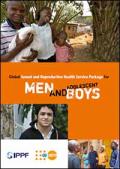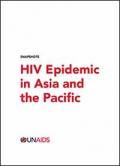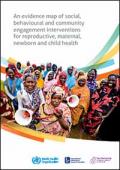What's New
Displaying results 1941 - 1950 of 4914

Resource | Publications,
The Global Sexual and Reproductive Health Service Package for Men and Adolescent Boys has been developed to support providers of sexual and reproductive health services. It aims to increase the range and quality of sexual and reproductive services provided that meet the specific and diverse needs of men and adolescents boys. It covers men and adolescent boys in all their diversity, and takes a positive approach to sexual and reproductive health, seeing this not just as the absence of disease, but the positive expression of one’s gender, sex and sexuality.
In doing so, this service package contributes to efforts to ensure universal access to sexual and reproductive health and rights (SRHR) as prioritized in the Sustainable Development Goals. This package is in no way intended to detract from the sexual and reproductive health and rights of women and adolescent girls, nor to divert resources, funding or attention from much-needed SRH services and programmes for women and adolescent girls.

Resource | Reviews and Snapshots,
UNAIDS Snapshot 2017: HIV epidemic in Asia and the Pacific is an interactive report with colourful infographics and bite-size information on the HIV epidemic and response on key populations at higher risk of HIV in Asia and the Pacific.

Resource | Publications,
In this year's AVAC Report—Mixed Messages and How to Untangle Them—we have set ourselves the task of clarifying the profoundly complex field of biomedical HIV prevention and research. This is never an easy task, but it is made all the more complicated— and exciting—in the current environment.
One definition of "mixed message" is "a showing of thoughts or feelings that are very different from one another." Based on this, the term "biomedical prevention" is itself a mixed message, since it suggests that there are prevention strategies that can be extricated from the messy reality of human behavior, social relations and structural arrangements that preserve and exacerbate inequalities. As the Global Forum on MSM & HIV points out, all biomedical options are fundamentally social in that they involve relationships with our bodies, partners, clinics, communities and countries.

Resource | Publications,
In a world of gender inequalities that disadvantage women and girls, publishing a report on how men are not being reached by health services and are not exercising their right to health may seem counterintuitive. It was indeed perplexing to learn that men were less likely than women to know their HIV status and less likely to access and adhere to HIV treatment. As a consequence, more men are likely to die of AIDS-related illnesses than women. As the world strives to reach the high levels of HIV service coverage required to end AIDS as a public health threat, this blind spot in the response to HIV can no longer be ignored.

Resource | Publications,
The vast majority of transgender people across the Asia-Pacific region are unable to obtain any official identification documents that reflect their gender identity. This lack of gender recognition fosters widespread social exclusion, stigma, discrimination and violence when individuals are perceived to deviate from gender norms because their gender identity and/or expression does not coincide with their sex assigned at birth.
This report, Legal Gender Recognition: A Multi-Country Legal and Policy Review in Asia, undertakes a comprehensive review of existing laws, policies and practices related to legal gender recognition for transgender people in nine countries in Asia: Bangladesh, China, India, Indonesia, Malaysia, Nepal, Pakistan, Philippines and Thailand.

Resource | Publications,
The Sustainable Development Goals (SDGs) mark an unprecedented commitment to “leaving no one behind” (LNB) and the articulation of the importance of addressing vulnerabilities and discrimination on a global scale.
As part of its contribution to LNB, the Gender, Equity and Human Rights (GER) Team in conjunction with other WHO Departments, has outlined four components of a Country Support Package, which provide country-level support to LNB and benefit health information systems, national health policies and strategies, and national health programmes.

Resource | Tools,
This tool for Monitoring human rights in contraceptive services and programmes contributes to the World Health Organization’s (WHO’s) ongoing work on rights-based contraceptive programmes.
This tool is intended for use by countries to assist them in strengthening their human rights efforts in contraceptive programming. The tool uses existing commonly-used indicators to highlight areas where human rights have been promoted, neglected or violated in contraceptive programming; gaps in programming and in data collection; and opportunities for action within the health sector and beyond, including opportunities for partnership initiatives.

Resource | Publications,
Social, behavioural and community engagement (SBCE) interventions are key to empowering individuals, families and communities to contribute to better health and well-being of women, children and adolescents. Policy-makers and development practitioners need to know which interventions work best.
This document provides an evidence map of existing research into a set of selected SBCE interventions for reproductive, maternal, newborn, and child health (RMNCH), the fruit of a collaboration between the WHO, the Partnership for Maternal, Newborn & Child Health (PMNCH) and the International Initiative for Impact Evaluations (3ie), supported by other partners. It represents an important way forward in this area, harnessing technical expertise, and academia to strengthen knowledge about the evidence base.

Resource | Publications,
This WHO global health financing report summarizes the latest internationally comparable data on health spending in all WHO Member States between 2000 and 2015. But it does more than publish the most recent data. For the first time the report uses the new international classification for health expenditures in the revised System of Health Accounts. This new framework enables the presentation of detailed information on the role of governments, households and donors in funding health services, and the financing arrangements through which these funds are channelled and spent.

Resource | Publications,
(Sankalak), a bulletin of Monitoring, Evaluation and Surveillance division, aims to report progress of the national AIDS response on select key indicators including the ones which are used to monitor the 2020 Fast-Track targets. It summarizes the data on epidemic, at national and State level, and shows progress made under the prevention, testing and treatment programme for financial year (FY) 2016-17. Sankalak is a response to the critical need for systematic analysis and dissemination of progress on indicators to stakeholders, including policy-makers, programme managers and technical staff in the National AIDS Control Programme (NACP).





